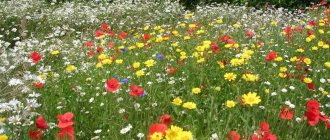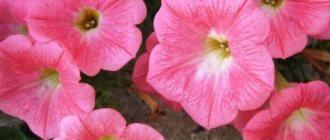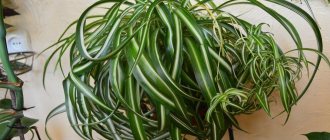Causes and characteristics of allergies to pollen from flowering plants
The main prerequisite for the development of plant allergies is the massive release of pollen into the air, which occurs from March to September. Depending on the sensitization of the body, an allergy can be observed to a specific plant, to several herbs of the same family, or to the pollen of a number of trees, weeds and cereal crops.
Pollen is the male reproductive cells of grasses and trees, which contain plant proteins. It is these protein compounds that cause the development of allergies to plants: when pollen gets on the mucous membranes and skin of people, it causes irritation. Due to its low weight and small size, its microparticles can be transported by wind over long distances. They can also be spread by insects and animals.
The main difference between pollen allergy and other atypical allergic reactions is its pronounced seasonal nature. Patients diagnosed with a flower allergy suffer from its symptoms at the same time for several years.
Symptoms of plant allergies in children and adults have not only a noticeable seasonality, but also some other distinctive features. The most pronounced signs of plant allergies are observed in dry, windy weather, when pollen spreads unhindered over long distances. In addition, we can distinguish daily periods of greatest pollen activity: from the moment the sun rises until 9-11 a.m., signs of allergy are most noticeable.
A predisposition to plant allergies may be due to the following factors:
- heredity;
- weakened immune system;
- bad habits: smoking and alcohol abuse;
- frequent acute respiratory diseases and bronchial asthma;
- living in an urban environment, occupational hazards.
Regarding the last point, the following should be noted. The number of plants that cause allergies to the skin and mucous membranes is much less in large cities than in rural areas. However, this does not mean that city residents are protected from plant allergies. On the contrary, due to relatively rare contact with allergens, the body of a city dweller is more vulnerable to the effects of pollen.
So-called cross-allergies may also occur. We are talking about a person eating certain vegetables and fruits and the appearance of reactions similar in symptoms to allergies to plants.
It must be borne in mind that an allergy to plants can develop not only as a response to inhalation of pollen, but also as a reaction to contact with other parts of herbs and trees - stems, leaves, seeds and the essential oils they contain.
Myths and dangerous misconceptions in the treatment of hay fever
The worst misconception when allergies appear due to flowering in the spring is the belief that the disease can be cured on your own, without the help of a doctor. Only a specialist, after diagnosis, will be able to determine which plants you are allergic to. Uncontrolled use of medications or folk remedies can only worsen a person’s condition. A professional allergist selects an individual treatment regimen for each patient. Being not an expert in this field, it is difficult to determine the selection and dosage of drugs correctly. If hay fever is treated incorrectly, complications often begin. Then, instead of one disease, a whole complex of diseases develops, the cure of which will be much more difficult and longer in time.
Plants that cause allergies
To be prepared for the possible occurrence of an atypical reaction, you need to know in advance which plants cause allergies. There are three main groups that are potentially dangerous for allergy sufferers:
- shrubs and trees: birch, alder, cypress, olive, poplar, hazel, cherry;
- cereal and meadow grasses: timothy, fescue, orchard grass, ryegrass, bromegrass, rye, bluegrass;
- weeds: ragweed, wormwood, quinoa, nettle.
Allergy to flowering plants by month (spring, summer and autumn) also has some characteristics. In central Russia there are three waves of hay fever:
- Spring wave of allergies. Lasts from March to May, due to the flowering of trees and bushes.
- Summer. Lasts from the beginning of June to the end of July, caused by pollen of meadow plants.
- Summer-autumn. Starts in August, ends in September. The cause of the appearance is weed pollen.
Treatment
This disease is currently not completely curable. However, if you follow all the doctor’s recommendations, you can significantly reduce the manifestations of allergies and alleviate your condition during the flowering period of plants. Hay fever is treated with medication. Each patient is individually selected for certain medications. In addition to this method, hyposensitization is prescribed. The patient is introduced to the causative allergens. At first, the doses are small, but gradually the concentration of the drug increases. At the end of therapy, a decrease in a person’s susceptibility to pollen allergen is observed. This makes it possible to reduce the manifestations of the disease.
Houseplants that cause allergies
Not only meadow plants, weeds and cereals can cause unusual reactions of the immune system. Allergies to indoor plants are not so common, but they can also bring a lot of trouble to an allergy sufferer. Please note: allergies at home can occur not only during the flowering period. Some indoor plants produce essential oils that can cause an atypical reaction in the body. Below is a small list of indoor plants that cause allergies:
- Geranium.
- House ferns.
- Azalea.
- Kalanchoe.
- Oleander.
- Hydrangea.
- Sedum.
- Rhododendron.
- Catharanthus.
If you find out in advance which indoor plants you are allergic to, you can decorate your home or office with exclusively safe flowers.
Why do some house plants cause allergic reactions?
Small particles from the surface of plant leaves enter the air. A person inhales them and causes a reaction in the body. This manifestation is often provoked by allergenic house flowers, which at first glance look completely harmless.
Moreover, it does not occur in all family members, but only in those who have an individual predisposition. People who are tolerant to allergens will not notice such evaporation. And those who are more susceptible to odors, and especially to allergens, will react.
Most often the problem is caused by pollen or plant sap . In some cases, we forget about other factors that are fraught with danger.
- House flowers are dampness, mold and fungus, inhabitants of the soil.
- The leaves of the flower collect dust - it can also provoke a reaction. Dust often becomes a haven for house mites.
Allergy to plants: symptoms
The first signs of a plant allergy usually appear within an hour of contact with the allergen. Their duration depends on the general health of the patient, as well as on the degree of sensitization to a particular plant. There are cases when symptoms of allergies to pollen from domestic, indoor and wild plants in children and adults do not stop for several weeks.
Signs of a plant allergy include the following:
- From the mucous membranes: swelling and tingling in the mouth and throat, severe sneezing, discharge of liquid mucus from the nose, sinusitis and sinusitis may develop.
- From the skin: an allergic rash on the body, accompanied by itching, redness of the skin, swelling (up to Quincke's edema), in some cases - dryness and flaking. Due to the release of a large amount of liquid secretion from the nose, patients rub their nose hard. This leads to redness of the skin above the upper lip and on the wings of the nose, peeling and increased sensitivity. To cope with these unpleasant symptoms, it is recommended to use La-Cri cream.
- From the eyes: redness of the whites, allergic conjunctivitis, lacrimation, photophobia, possible presence of purulent discharge, dark circles under the eyes.
- From the respiratory system: allergic dry cough, difficulty breathing with possible attacks of suffocation, a feeling of heaviness and constriction in the chest; in the presence of bronchial asthma, its exacerbation may occur.
- From the ears: the appearance of crackling and noise in the ears, decreased hearing acuity.
In addition to these signs, an allergy to plants may cause symptoms such as lethargy, irritability, loss of appetite, headache, dizziness, slight fever, nausea, and problems sleeping.
How to avoid bringing an allergen home?
If you like a flower in a specialty store, ask the seller to tell you about it. Garden centers that value their name have qualified staff and their advice can be trusted. In addition, you can Google the name of the plant and the World Wide Web will give you the full breakdown - all the pros and cons.
It is necessary to pay attention first of all to your own well-being and the condition of your household.
If unpleasant symptoms appear after purchasing a plant, it is advisable to exclude contact with the irritant and promptly visit a medical facility.
Allergy to plants: treatment and diagnosis
The choice of means for the treatment of allergies to flowering plants depends on the course of hay fever. Experts distinguish three degrees of severity of this reaction:
- Light. In the case of a mild allergy to plants, patients have mild symptoms of rhinitis and conjunctivitis, which do not interfere with daytime activity and sleep. Treatment may be limited to taking medications for the period of exacerbation (flowering).
- Average. Moderate severity of allergies can cause noticeable discomfort. Symptoms of hay fever interfere with work, study, sports, and disrupt the patient’s sleep. In this case, medications are prescribed before the flowering period (preparation).
- Heavy. This is the most dangerous type of plant allergy, in which the symptoms of hay fever can significantly affect the patient’s quality of life, work and rest. In particularly severe cases, hospitalization is possible.
How to treat allergies to flowering plants should be decided by an allergist. Based on the intensity of the symptoms and the overall picture of the development of the atypical reaction, the specialist will be able to prescribe appropriate therapy. However, it must be borne in mind that treatment of symptoms of pollen allergy can take a long time. In some cases, specific immunotherapy may be required and continued for several months. Therefore, before starting treatment, you need to be patient - especially in cases of severe allergies.
If the first manifestations of an allergy occur, it is recommended to consult a doctor as soon as possible. Because hay fever (especially in its early stages) shares many similarities with respiratory illnesses, it is important to make an accurate diagnosis. The following methods can be used to diagnose plant allergies:
- blood test to determine IgE;
- analysis of secretions released from the nose;
- analysis of sputum produced when coughing;
- skin tests;
- provocative tests (mainly performed in a hospital setting).
Depending on the test results, antihistamines, vasoconstrictors, decongestants, corticosteroid drugs for allergies, as well as local non-hormonal and hormonal agents may be prescribed.
Particular attention should be paid to the use of ointments, gels and creams for allergies: how quickly the itching of the skin goes away depends on how well they are selected. Itching due to allergies leads to scratching of the rash, and infection can get into the scratching areas. Infection of scratched areas of the body can lead to inflammation and suppuration inside the lesion.
Recently, doctors are increasingly suggesting that allergy sufferers undergo a course of specific immunotherapy. This refers to the systematic introduction of small doses of an allergen into the body. Successful treatment of allergies may require about 3-5 courses of specific immunotherapy. The procedures are carried out during the period of attenuation of allergies - in autumn and winter.
While undergoing treatment for pollen allergies, you must follow a diet. It is recommended to avoid eating seafood, fish, smoked meats, products with artificial colors and preservatives, ketchup, mayonnaise, mustard, honey, alcohol, chocolate, sweet yeast baked goods, red and orange vegetables and fruits. To avoid cross-allergic reactions, it is worth temporarily excluding tomatoes, leeks, carrots, celery, garlic and sweet peppers, apples, etc. from your diet.
Patients who decide to try allergy treatment with medicinal plants should be especially careful. Due to the fact that they have an increased sensitivity to herbs, herbal remedies, medicinal mixtures and herbal tinctures may not have the desired effect, and on the contrary, worsen the course of the disease. When choosing herbal medicine, you should consult your doctor.
Causes
The negative symptoms of the disease are a consequence of the response of the immune system, which reacts sharply to essentially safe substances from the environment.
Why is this happening? There is no clear answer to this.
Scientists have put forward the following version:
Allergies are caused by a genetic predisposition in combination with the lifestyle features of modern humans (active use of antibacterial drugs from the first months of a newborn’s life, minimal contact with wildlife, excessive measures to disinfect the surrounding space, etc.)
How to get rid of pollen allergies: useful tips
During the seasonal exacerbation of allergies, it is recommended to spend as little time as possible outside. The greatest pollen activity occurs in the morning and late evening: from sunrise to 11 a.m. and from approximately 8 p.m. to midnight.
If there is such a possibility, during the flowering of plants that cause allergies (see list above), it would be useful to move to a place with a more favorable climate. For example, humid regions or coastal areas tend to have lower concentrations of pollen in the air.
Dry, windy weather creates ideal conditions for the spread of pollen particles. If it rains or the weather is damp, the likelihood of an allergy exacerbation is much less.
When going outside, it is recommended to wear a respirator, special nose filters, and sunglasses: their glasses will at least partially protect your eyes from the allergen.
Upon returning indoors, you should thoroughly wash your hands and face with cool water to remove any remaining pollen. If you are allergic to plants, it is recommended to shower and rinse your hair daily.
It is advisable to install an air conditioner with an air purification system or special air purifiers in the house. If this is not possible, you need to carry out wet cleaning as often as possible, remove carpets and cover windows with wet gauze pieces.
If you are allergic to flowering, you should not bring bouquets of field and meadow plants into your home.
During an exacerbation of allergies, you will have to give up trips to nature, outside the city, and walks in forested areas.
If you have allergies, it is advisable to reduce close contact with pets if they go outside for walks. Cats and dogs can bring particles of pollen into the house that have settled on their fur.
Recommendations for relief
Any actions aimed at reducing contact with pollen lead to a weakening of clinical manifestations and prevent the development of complications. These include:
- Installing gauze nets on all windows (if possible, it is better to keep them closed, but use nets when ventilating);
- Wet cleaning of the premises daily;
- Reducing exposure to fresh air if possible, wearing special masks;
- Performing acupressure of the nose to reduce congestion and swelling;
- Maintaining a gentle diet with the exclusion of allergy-causing foods.
Traveling to an area where there is no plant that causes an allergic reaction allows you to completely eliminate the symptoms of the disease. But few adults are able to leave every year.
La-Cri cream is your assistant in the fight against skin symptoms of plant allergies
To cope with itching, redness and rashes that appear on the skin due to allergies to plants, we recommend that you use La-Cri restorative cream. Thanks to its constituent extracts of violet, string, walnut, avocado oil, as well as panthenol and bisabolol, the cream fights skin allergies. It provides necessary hydration and nutrition to the skin, helps cope with inflammation and itching, and has a softening effect. The composition of the cream is completely safe, so its use is allowed even for children and pregnant women.
Types of hypersensitivity
The Jell and Coombs classification has been used in medicine since 1969. It shows that the mechanisms of development of allergic reactions are different.
Type I (anaphylactic) . Marker - Immunoglobulin E. Development time - from several minutes to one hour. Examples: rhinitis, conjunctivitis, asthma, Quincke's edema, urticaria, anaphylactic shock.
Type II (cytotoxic). Marker - IgM and IgG antibodies. Development time is several hours. Examples: autoimmune hemolytic anemia, transplant rejection, Rh conflict.
Type III (immune complex). Marker - Fixed immune complexes. Development time is from several hours to several days. Examples: serum sickness, rheumatoid arthritis, hypersensitivity pneumonitis, Arthus phenomenon.
Type IV (slow). Marker - T-lymphocytes. Development time - several days Examples: contact dermatitis, food gastroenteropathy, immune response to tuberculin, drug hypersensitivity.
Allergens directly cause reactions of the first or fourth type. These are usually low molecular weight proteins that, when ingested, trigger the release of immunoglobulin E or the activation of T cells.
Experts' opinion
Clinical studies conducted by Vertex have proven the effectiveness, safety and tolerability of the products. The products are suitable for daily care of children's skin with mild and moderate forms of atopic dermatitis during remission. As a result of using the products, a decrease in the activity of inflammation, dryness, itching and flaking was noted.
It has been proven that La Cree cream eliminates dryness and flaking of the skin, retains its own moisture and, importantly, protects the skin from cold and wind. Cream for sensitive skin significantly reduces itching and irritation, relieves redness of the skin, moisturizes and gently cares for it.
The creams are recommended by the St. Petersburg branch of the Union of Pediatricians of Russia.
Sources:
- B.A. Shamov, I.G. Safiullina, A.B. Beshimova, T.B. Shamov, Differential diagnosis of atopic dermatitis, journal of Practical Medicine, 2011 cyberleninka.ru/article/v/differentsialnaya-diagnostika-atopicheskogo-dermatita
- Fokina R.A., Atopic dermatitis: stages of development of classification forms, Siberian Medical Journal, 2007 cyberleninka.ru/article/v/atopicheskiy-dermatit-etapy-razvitiya-klassifikatsionnyh-form
- A.N. Pampura, A.A. Chuslyaeva, Modern approaches to the treatment of atopic dermatitis in children cyberleninka.ru/article/v/sovremennye-podhody-k-terapii-atopicheskogo-dermatita-u-detey
Photos of allergies in children
Photo album on the diseasePrevention
It is very difficult to avoid an allergic reaction to pollen. If the body is sensitized, it is very difficult to restore it completely. However, it is possible to reduce the clinical symptoms of allergy and prevent a severe reaction during the flowering period. Therefore, you need to know when the plant to which the sick person is allergic blooms, and take a course of antihistamines a week or two before symptoms develop3. For this you can use Cetrin.
Bibliography:
- Simons FE. Advances in H1-antihistamines. N Engl J Med. 2004.
- Allergic rhinitis etiology, pathogenesis, features of pharmacotherapy: method, recommendation. Text. / compiled by: S. V. Ryazantsev, V. I. Kocherovets, A. A. Maryanovsky. - St. Petersburg: National Register. — 2007 — 40 s
- Zaikov S.V. Modern ideas about the treatment of hay fever. Wedge. immunol. allergol. Infectol., 2008, 3(14): 49–54.
- Polosyants O.B. Review of first and second generation antihistamines, rational approach to use in clinical practice / O.B. Polosyants // Attending physician. – 2011. – No. 7. – P. 66–68.
Skin tests
Diagnosis using skin testing allows one to identify in advance a person’s tendency to allergies. It is prohibited to carry out during an exacerbation of any disease, as well as if there is a history of anaphylactic shock. There are several ways to do a skin test: • Patch test. An applicator soaked in an allergen solution is applied to the skin. The reaction is assessed within 48 hours. • Prick test. A drop of a provoking substance is applied to the scratch. Observation takes up to 40 minutes. • Subcutaneous. The antigen is administered using a syringe (similar to the Mantoux test). In practice it is rarely used due to excessive aggressiveness.
In rare cases, respiratory tests (nasal or bronchial) are used instead of skin tests. Thus, to detect occupational asthma, the patient, under the supervision of a doctor, inhales an irritating substance identified at the workplace.
How to recognize angioedema?
It is characterized by swelling of the subcutaneous tissue and effusion of intravascular fluid. The cause is often food, medicine or an insect bite, less often - plant pollen. The swelling is usually asymmetrical and causes pain in the person.
Quincke's edema can be determined by visual signs. Usually affected: • lips; • language; • eyelids; • neck; • limbs; • genitals. An ambulance should be called immediately, since in an acute condition the respiratory tract is often affected. The condition is similar to an asthma attack - swelling of the larynx causes its stenosis (narrowing). This leads to decreased respiratory function, which increases the risk of death. Moreover, the chronic form of the disease is no less dangerous than the acute one.
Symptoms of hay fever
Hay fever is a seasonal disease; its symptoms appear only when the corresponding allergen plant blooms. The condition usually worsens in the morning, when there is especially a lot of pollen in the air. Dry and windy weather also contributes to poor health, but when it rains, the air is cleared of pollen, and the disease recedes.
The main symptoms of the disease are:
Allergic conjunctivitis
Allergic conjunctivitis is a typical manifestation of hay fever. The eyes begin to water, the eyelids swell and itch, the mucous membranes turn red, it hurts to look at the light, it feels as if sand has gotten into the eyes.
Allergic rhinitis
Another typical manifestation of hay fever is allergic rhinitis. The nose is itching, nasal breathing is disrupted, there is copious mucous discharge, and bouts of sneezing - sometimes 10-30 sneezes in a row.
Asthmatic attacks
In severe cases, hay fever can manifest itself in the form of asthmatic attacks.
Hives
Urticaria and allergic dermatitis may also occur.
More about the symptom











